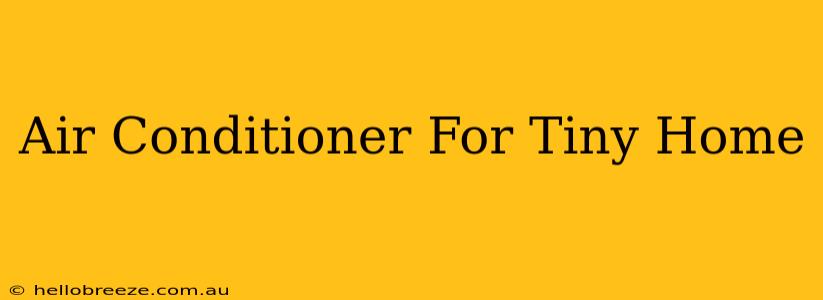Choosing the right air conditioner for a tiny home presents unique challenges. Space is at a premium, and energy efficiency is paramount. This guide will help you navigate the options and find the perfect cooling solution for your cozy abode.
Understanding Your Tiny Home's Cooling Needs
Before diving into specific AC units, assess your tiny home's cooling requirements. Consider these factors:
- Square Footage: This is the most basic factor. Smaller spaces require less powerful units.
- Insulation: Proper insulation significantly impacts cooling efficiency. Well-insulated tiny homes will need less powerful AC units.
- Climate: Hot and humid climates demand more powerful and efficient AC units.
- Number of Occupants: More people generate more heat, increasing the cooling load.
- Appliance Heat Output: Appliances like ovens and refrigerators generate heat, impacting the overall cooling needs.
Types of Air Conditioners for Tiny Homes
Several AC types suit tiny homes. Let's explore the pros and cons of each:
1. Window Air Conditioners
- Pros: Affordable, relatively easy to install, effective for smaller spaces.
- Cons: Can obstruct windows, not aesthetically pleasing for everyone, may not be suitable for all window types. Consider: Window air conditioners are a popular choice for their simplicity and cost-effectiveness, especially for smaller tiny homes. Look for models with high Energy Star ratings to minimize energy consumption.
2. Portable Air Conditioners
- Pros: Flexible placement, no installation required, can be moved between rooms.
- Cons: Less efficient than window units, require venting, can be noisy, take up floor space. Consider: Portable AC units offer flexibility, but their efficiency might be lower, especially in larger tiny homes. Ensure proper venting to maximize performance.
3. Ductless Mini-Split Systems
- Pros: Energy efficient, quiet operation, can heat and cool, sleek design.
- Cons: More expensive upfront cost, professional installation required. Consider: Mini-split systems are a premium option offering superior efficiency and comfort. The initial investment is higher but could be offset by lower energy bills over time. They are a great option for long-term living in a tiny home.
4. Evaporative Coolers (Swamp Coolers)
- Pros: Energy efficient, affordable, adds humidity (beneficial in dry climates).
- Cons: Ineffective in high humidity climates, requires regular maintenance and cleaning. Consider: Evaporative coolers are best suited for dry climates. They won't provide the same level of cooling as other types but are a cost-effective alternative in appropriate conditions.
Choosing the Right BTU Rating
BTU (British Thermal Unit) rating indicates the cooling capacity of an AC unit. A higher BTU rating means more powerful cooling. Use an online BTU calculator to determine the appropriate BTU rating based on your tiny home's square footage and climate. Choosing a unit with too low a BTU rating will leave your home undercooled, while a unit with too high a rating will be inefficient and costly.
Energy Efficiency: A Priority for Tiny Homes
Energy efficiency is crucial for tiny home living. Look for air conditioners with high Energy Star ratings. These ratings indicate energy efficiency and help minimize your energy costs.
Installation and Maintenance
Proper installation is key to optimal performance and energy efficiency. Consider professional installation, particularly for mini-split systems. Regular maintenance, such as cleaning filters, will extend the life of your AC unit and maintain its efficiency.
Conclusion: Cool Comfort in Your Tiny Home
Selecting the right air conditioner is a vital step in creating a comfortable and energy-efficient tiny home. By considering your specific needs and carefully evaluating the different options, you can find the perfect cooling solution to keep your space cool and comfortable, no matter the weather. Remember to always consult with professionals for complex installations and to ensure compliance with local building codes.

